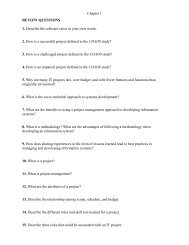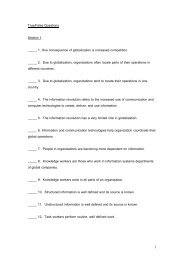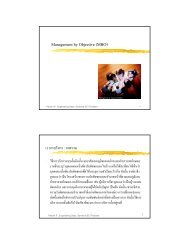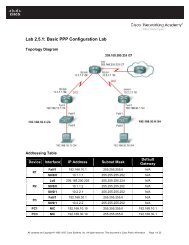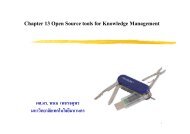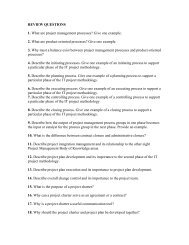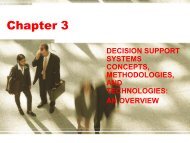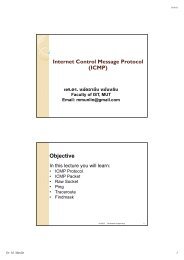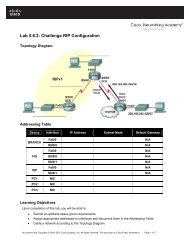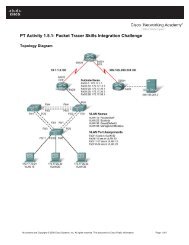Concepts in Enterprise Resource Planning
Concepts in Enterprise Resource Planning
Concepts in Enterprise Resource Planning
- No tags were found...
You also want an ePaper? Increase the reach of your titles
YUMPU automatically turns print PDFs into web optimized ePapers that Google loves.
<strong>Concepts</strong> <strong>in</strong> <strong>Enterprise</strong> <strong>Resource</strong> Plann<strong>in</strong>gChapter FourProduction and Supply Cha<strong>in</strong> Management Information Systems
ObjectivesAfter complet<strong>in</strong>g this chapter, you will be able to:• อธิบายขั้นตอนตาง ๆ ในกระบวนการวางแผนการผลิต (production plann<strong>in</strong>gprocess) ของโรงงานผลิตสินคาคราวละมาก ๆ (high-volume manufacturer)ตัวอยางเชน Fitter Snacker• อธิบายถึงปญหาตาง ๆ ดานการจัดการวัตถุดิบและการผลิตของ Fitter Snacker• อธิบายวา กระบวนการวางแผนที่เปนโครงสรางของโซอุปทานชวยทําใหประสิทธิภาพและการทําการตัดสินใจดีขึ้นไดอยางไร• อธิบายวา ขอมูลการวางแผนฝายผลิตในระบบ ERP สามารถนํามาใชรวมกับซัพพลายเออรเพื่อเพิ่มประสิทธิภาพของโซอุปทานไดอยางไร• การจัดการโซอุปทานในระบบ ERP2
Introduction• Fitter Snacker ถือเปนสวนหนึ่งของโซอุปทาน• ปญหาการจัดการโซอุปทานของ FS และ ERP ชวยแกไขไดอยางไรSnack Bar3
Production Overview (cont’d.)• ในการผลิตนั้นโดยทั่วไปจะมี 3 แนวทางดวยกัน คือ• ผลิตสินคาเพื่อจัดเก็บ (Make-to-stock items): ผลิตเปนสินคาคงคลัง (เก็บเขา“stock”) ตามการคาดหมายของการสั่งขาย (sales orders)• ผลิตสินคาตามคําสั่ง (Make-to-order items): ผลิตเพื่อใหไดตามขอกําหนดของคําสั่งของลูกคา (specific customer orders)• ประกอบสินคาตามคําสั่ง (Assemble-to-order items): ผลิตโดยใชสองกระบวนการรวมกัน คือ กระบวนการของ make-to-stock และ กระบวนการของ make-to-order5
Fitter Snacker’s Manufactur<strong>in</strong>g Process• Fitter Snacker ใชการผลิตแบบ make-to-stockFigure 4-1 Fitter Snacker’s manufactur<strong>in</strong>g process6
Fitter Snacker’s Production Problems• Fitter Snacker มีปญหาที่ตองตัดสินใจวา จะผลิตจํานวนกี่แผน และ จะตองผลิตเมื่อใด• ปญหาดานการสื่อสาร (Communication problems)• คนของฝายขายและฝายการตลาดไมยอมแบงปนขอมูลใหกับคนของฝายผลิต• คนของฝายผลิตพบวา มันเปนเรื่องยุงยากที่จะรับมือกับความตองการสินคาที่เพิ่มขึ้นอยางฉับพลันทันที (sudden <strong>in</strong>creases <strong>in</strong> demand)• ซึ่งทําใหเกิด shortages หรือ stockout8
Fitter Snacker’s Production Problems (cont’d.)• ปญหาดานสินคาคงคลัง (Inventory problems)• ผูจัดการฝายผลิต (Production manager) ขาดวิธีการอยางเปนระบบในการ:• ดําเนินการผลิตใหสอดรับกับ sales demand• การปรับการผลิตใหสะทอนกับ actual sales• ปญหาดานบัญชีและการจัดซื้อ• Standard costs: normal costs of manufactur<strong>in</strong>g a product• ฝายการผลิตและบัญชีตองทําการเปรียบเทียบ standard costs กับ actual costsอยางสม่ําเสมอและปรับแกใหถูกตองในกรณีที่เกิดความแตกตางขึ้นมา9
The SAP ERP Approach to Production Plann<strong>in</strong>gFigure 4-2 The production plann<strong>in</strong>g process11
Sales Forecast<strong>in</strong>g• ระบบ ERP ของ SAP ใชแนวทางบูรณาการเขาดวยกัน• เมื่อใดก็ตามที่การขายถูกบันทึกใน Sales and Distribution (SD) module, ปริมาณ(จํานวน)ที่ขายไปจะถูกบันทึกในเชิง consumption value ของ material (หรือกลาวงาย ๆ วา บันทึกอยูในรูปของวัตถุดิบที่ถูกใชไปในการผลิตสินคาทั้งหมด)• เทคนิคในการพยากรณอยางงาย (Simple forecast<strong>in</strong>g technique)• ใชยอดขายในชวงกอนหนานี้ (prior period’s sales) แลวทําการปรับภาพนั้นใหเขากับสถานการณ (ขอกําหนด)ในปจจุบัน (current conditions)• การทําการพยากรณสําหรับ Fitter Snacker:• ใชขอมูลยอดขายของปที่ผานมา มารวมเขากับ market<strong>in</strong>g <strong>in</strong>itiatives เพื่อเพิ่มยอดขาย12
Sales Forecast<strong>in</strong>g (cont’d.)เอาขอมูลแตละเดือนของปที่แลวมาเปนฐานตองการ Growth เดือนละ 3%เมื่อเทียบกับแตละเดือนของปที่แลวPromotion ทําใหนาจะขายไดเพิ่มอีกเทาใดFigure 4-3 Fitter Snacker’s sales forecast for January through June13
Sales and Operations Plann<strong>in</strong>g• แผนการขายและการดําเนินการ (Sales and operations plann<strong>in</strong>g (SOP))• Input: การพยากรณยอดขายจากฝายการตลาด• Output: แผนการผลิตที่ออกแบบจนแลวเสร็จอันเปนการทําใหสมดุลกันระหวางความตองการของตลาดกับกําลังผลิตที่มี (production capacity)• แผนการผลิตเปนอินพุตของขั้นตอนตอไป, demand management14
Sales and Operations Plann<strong>in</strong>g (cont’d.)Figure 4-5 Fitter Snacker’s sales and operations plan for January through June15
Sales and Operations Plann<strong>in</strong>g (cont’d.)• ใน SAP ERP การพยากรณยอดขายสามารถทําไดโดยการใช:• ขอมูลการขายในอดีตจาก Sales and Distribution (SD) module• อินพุตจากแผนที่ไดรับการพัฒนาใน Controll<strong>in</strong>g (CO) module• CO module:• Profit goals (เปาหมายทางดานผลกําไร)ขององคกรสามารถกําหนดไดที่นี่• ระดับยอดขายที่ตองการเพื่อใหบรรลุ profit goals สามารถประเมินได16
Sales and Operations Plann<strong>in</strong>g (cont’d.)Figure 4-6 Sales and operations plann<strong>in</strong>g screen <strong>in</strong> SAP ERP17
Sales and Operations Plann<strong>in</strong>g (cont’d.)• Rough-cut plann<strong>in</strong>g: common term <strong>in</strong> manufactur<strong>in</strong>g for aggregate plann<strong>in</strong>g• การแยกภาพรวม (Disaggregate) เปนการสรางตารางการผลิตอยางละเอียด (detailed production schedules)• เมื่อระบบ SAP ERP สรางการพยากรณออกมา ผูวางแผนสามารถดูผลลัพธในรูปแบบกราฟฟคได (results graphically)• Rough-cut capacity plann<strong>in</strong>g เปนการประยุกต simple capacity-estimat<strong>in</strong>gtechniques กับ production plan เพื่อดูความเปนไปไดของแผน (ในภาพรวมอยางคราว ๆ)18
Sales and Operations Plann<strong>in</strong>g (cont’d.)Figure 4-9 Forecast<strong>in</strong>g results presented graphically <strong>in</strong> SAP ERP19
Sales and Operations Plann<strong>in</strong>g (cont’d.)• การสวน(การแยกภาพรวม) ของ sales and operations plan• โดยทั่วไปบริษัทตาง ๆ ไดสราง sales and operations plans สําหรับกลุมสินคาขึ้นมาหลายกลุม (product groups)• ระบบ SAP ERP ยอมใหกําหนดตัวเลขของสินคาตาง ๆ เขาไปในกลุมสินคาหนึ่ง ๆ• Sales and operation plan ที่ถูกแยกแลว• ปริมาณที่กําหนดไวในแผนการผลิตซึ่งเปนกลุม ๆ จะถูกโอนไปสูสินคาแตละชนิดเพื่อผลิตขึ้นมา เมื่อรวมแลวจะไดเปนกลุมตามที่กําหนดไว20
Sales and Operations Plann<strong>in</strong>g (cont’d.)Figure 4-11 Product group structure <strong>in</strong> SAP ERP21
Sales and Operations Plann<strong>in</strong>g (cont’d.)Figure 4-12 Stock/Requirements List for NRG-A bars after disaggregation22
Demand Management• เปนการเชื่อม (L<strong>in</strong>k) sales and operations plann<strong>in</strong>g process เขากับ detailedschedul<strong>in</strong>g และ materials requirements plann<strong>in</strong>g processes• Output: master production schedule (MPS)• แผนการผลิตเพื่อผลิตสินคาสําเร็จรูปทั้งหมด• ในกรณีของ Fitter Snacker, MPS เปนอินพุตเขาไปยัง detailed schedul<strong>in</strong>g ซึ่งระบุวาแผนสแน็กประเภทไหนที่ตองผลิต และจะผลิตเมื่อใด23
Demand Management (cont’d.)Figure 4-14 Fitter Snacker’s production plan for January: The first five weeks ofproduction are followed by a day-by-day disaggregation of week 124
Materials Requirements Plann<strong>in</strong>g (MRP)• จะระบุถึงปริมาณและระยะเวลา (tim<strong>in</strong>g) ที่ตองการจากการผลิต หรือ การจัดซื้อของ subassemblies และ raw materials ที่ตองใชเพื่อใหการสนับสนุน MPS• Bill of material (BOM): list of the materials (<strong>in</strong>clud<strong>in</strong>g quantities) needed tomake a product25
Materials Requirements Plann<strong>in</strong>g (MRP) (cont’d.)Figure 4-16 The bill of material (BOM) for Fitter Snacker’s NRG bars26
Materials Requirements Plann<strong>in</strong>g (MRP) (cont’d.)• เวลานํา (Lead time) และ การกําหนดขนาดของล็อต (lot siz<strong>in</strong>g)• Lead time: เวลารวมทั้งหมด (cumulative time) ที่ซัพพลายเออรตองการตั้งแตรับใบสั่งซื้อวัตถุดิบจากโรงงานผูผลิตสินคา ประมวลใบสั่งซื้อ นําวัตถุดิบออกจากสต็อกของเขา บรรจุภาชนะหอหุม นําขึ้นรถบรรทุก และจัดสงมาถึงโรงงานผูผลิตสินคา• Lot siz<strong>in</strong>g: การกําหนดปริมาณการผลิตและปริมาณการสั่งซื้อ• MRP record: standard way of view<strong>in</strong>g the MRP process on paper27
Materials Requirements Plann<strong>in</strong>g (MRP) (cont’d.)Figure 4-17 The MRP record for oats <strong>in</strong> NRG bars, weeks 1 through 528
Materials Requirements Plann<strong>in</strong>g <strong>in</strong> SAP ERP• รายการใน MRP แสดงผลลัพธตาง ๆ ที่ MRP คํานวณออกมา• กระบวนการของ MRP ไดแสดงถึงการสั่งวัตถุดิบที่ถูกแผนเอาไวแลวซึ่งสอดรับกับความตองการสินคา• Stock/Requirements List shows:• Planned orders• Purchase requisitions (PurRqs)• Purchase orders (POitem)• ผูวางแผนสามารถเปลี่ยนการสั่งวัตถุดิบที่ถูกวางแผนเอาไวแลวนั้นใหเปนการสั่งซื้อจาก Stock/Requirements List โดยการ double-click<strong>in</strong>g ที่ planned order l<strong>in</strong>e29
Materials Requirements Plann<strong>in</strong>g <strong>in</strong> SAP ERP (cont’d.)Figure 4-18 The MRP list <strong>in</strong> SAP ERP30
Materials Requirements Plann<strong>in</strong>g <strong>in</strong> SAP ERP (cont’d.)Figure 4-19 The Stock/Requirements List <strong>in</strong> SAP ERP31
Materials Requirements Plann<strong>in</strong>g <strong>in</strong> SAP ERP (cont’d.)• สารสนเทศที่ถูกบูรณาการเขาดวยกันยอมใหฝายจัดซื้อทําการตัดสินใจที่ดีที่สุดเกี่ยวกับตัวแทนจําหนายบนพื้นฐานของสารสนเทศที่เกี่ยวของและทันสมัย• เมื่อพนักงานฝายจัดซื้อตัดสินใจวาจะซื้อจากผูขายรายใด เขาก็จะสงคําสั่งซื้อไปที่ผูขายรายนั้น• ระบบสามารถติดตั้งใหสามารถแฟกซการสั่งซื้อไปใหผูขาย หรือ สงทางอิเล็กทรอนิคสผานทาง EDI (electronic data <strong>in</strong>terchange) หรือ สงไปทางเครือขายอินเตอรเน็ต32
Detailed Schedul<strong>in</strong>g• Detail Schedul<strong>in</strong>g คือ แผนที่มีรายละเอียดวาอะไรที่ตองถูกผลิต โดยพิจารณาถึงกําลังเครื่องจักรและแรงงานที่มีอยู• ปจจัยติดสินใจหลักใน detailed production schedul<strong>in</strong>g คือ• จะทําฝายผลิตผลิตแตละสินคานานเทาใด• ความยาวการของรันของฝายผลิต (production run length) จําเปนตองสมดุลกันระหวาง setup costs และ hold<strong>in</strong>g costs เพื่อทําให total costs ขององคกรต่ําที่สุด33
Detailed Schedul<strong>in</strong>g (cont’d.)• Fitter Snacker ใชการผลิตแบบซ้ํา ๆ (repetitive manufactur<strong>in</strong>g)• Repetitive manufactur<strong>in</strong>g environments โดยทั่วไปแลวจะประกอบดวยสายการผลิตตาง ๆ ที่ถูกเปลี่ยนจากสินคาชนิดหนึ่งไปสูสินคาอีกชนิดหนึ่งที่คลายกันไดงาย• สายการผลิตจะถูกจัดตารางเวลาการผลิตในเชิงของชวงเวลา (period of time)แทนที่จะเปนจํานวนสินคาตามที่ระบุ (specific number of items)34
Detailed Schedul<strong>in</strong>g (cont’d.)Figure 4-22 Repetitive manufactur<strong>in</strong>g plann<strong>in</strong>g table <strong>in</strong> SAP ERP35
Detailed Schedul<strong>in</strong>g (cont’d.)• Production runs ควรตองทําการตัดสินใจโดยอาศัยการประเมิน cost of equipmentsetup และ hold<strong>in</strong>g <strong>in</strong>ventory• ระบบสารสนเทศที่ไดรับการบูรณาการเขาดวยกันแลวจะทําการเคราะหสิ่งเหลานี้ไดงาย• การรวบรวมสารสนเทศทางบัญชีโดยอัตโนมัติทําใหผูจัดการสามารถประเมินschedule trade-offs ในเทอมของตนทุนตาง ๆ ของบริษัทไดดีขึ้น36
Provid<strong>in</strong>g Production Data to Account<strong>in</strong>g• ในโรงงานผลิต ERP packages จะไมตอโดยตรง ๆ กับเครื่องจักรที่ใชผลิต• ขอมูลจะถูกปอนมายัง SAP ERP ผานทาง PC ที่อยูใน shop floor เชน การสแกนโดยใช barcode reader หรือ ปอนผาน wireless PDA เปนตน• เทคโนโลยีของ Radio frequency identification (RFID) ทําใหการรวบรวมขอมูลงายขึ้น• ใน <strong>in</strong>tegrated ERP system การลงบัญชีของ material transaction จะเปนไปโดยอัตโนมัติ37
Provid<strong>in</strong>g Production Data to Account<strong>in</strong>g (cont’d.)• เมื่อ FS ไดรับ shipment ขอวัตถุดิบ การรับของ (Receiv<strong>in</strong>g) ตองแจงใหระบบ SAPERP ทราบวามีวัตถุดิบเขามา และไดรับของเขาไปแลว (acceptance of the material)• Goods receipt transaction• ฝายรับของ (Receiv<strong>in</strong>g department) ตองตรวจสอบวา ของที่รับเขามากับของที่สั่งซื้อไปใน purchase order ตรงกันหรือไม• เมื่อการรับของถูกบันทึก ระบบ SAP ERP จะเพิ่มยอดวัตถุดิบในสินคาคงคลังทันที38
Provid<strong>in</strong>g Production Data to Account<strong>in</strong>g (cont’d.)Figure 4-23 Goods receipt screen <strong>in</strong> SAP ERP39
ERP and Suppliers• Fitter Snacker ถือเปนสวนหนึ่งของ supply cha<strong>in</strong>• เริ่มจากเกษตรกรปลูกขาวโอต (oats) และขาวสาลี (wheat)• จนไปจบที่ ลูกคาซื้อ NRG bar จากรานคาปลีก (retail store)• ระบบ ERP สามารถเลนบทบาทที่สําคัญในการวางแผนทํางานรวมกัน (collaborativeplann<strong>in</strong>g)40
ERP and Suppliers (cont’d.)• การทํางานรวมกับซัพพลายเออรในเชิงการรวมมือกันทํางานนั้น ยอมตองการความไววางใจซึ่งกันและกันในทุก ๆ ฝาย• บริษัทยอมใหซัพพลายเออรเขามาดูบันทึกที่เกี่ยวของได• ซัพพลายเออรสามารถอานขอมูลของบริษัทได เพราะวามันใช data formats ที่เหมือนกัน• ขอดี• ลดงานดานเอกสาร (paperwork)• ประหยัดเวลา• ประปรุงประสิทธิภาพในสวนอื่น ๆ41
The Traditional Supply Cha<strong>in</strong>• Supply cha<strong>in</strong>: กิจกรรมทั้งหมดที่เกิดระหวางการปลูก หรือ การเก็บเกี่ยววัตถุดิบ(ขางโอต ขาวสาลี) จนกระทั่งไดเปนสินคาสําเร็จรูปออกมาวางขายใหลูกคาในรานคา• โซอุปทานแบบเดิม (Traditional supply cha<strong>in</strong>)• สารสนเทศถูกสงผานไปตามโซอุปทานในเชิงการสนองตอบโดยการเพิ่มการสั่งสินคาของเขา• การลาชาทางดานของเวลา (time lags) จะทําใหเกิดปญหา42
The Traditional Supply Cha<strong>in</strong> (cont’d.)Figure 4-24 Supply cha<strong>in</strong> management (SCM) from raw materials to consumer43
The Traditional Supply Cha<strong>in</strong> (cont’d.)• EDI และ ERP• กอนระบบ ERP จะเกิดขึ้นนั้น บริษัทตาง ๆ เชื่อตอเขากับซัพพลายเออรและลูกคาผานทาง electronic data <strong>in</strong>terchange (EDI) systems• ระบบ ERP ที่ผานการพัฒนามาดีแลว จะชวยในเรื่องการจัดการโซอุปทาน SCM• เพราะการวางแผนการในสิ่งที่ตองการและระบบการจัดซื้อไดอยูใน ERPแลว• โดยการใชระบบ ERP การแบงปนแผนการผลิตตลอดทั่วทั้งโซอุปทานนั้น จะเกิดขึ้นแบบ real time44
The Measures of Success• Performance measurements• Metrics• Show the effects of better supply cha<strong>in</strong> management• Cash-to-cash cycle time• Time between pay<strong>in</strong>g for raw materials and collect<strong>in</strong>g cash from customer• SCM costs• Include cost of buy<strong>in</strong>g and handl<strong>in</strong>g <strong>in</strong>ventory, process<strong>in</strong>g orders, and<strong>in</strong>formation systems support45
The Measures of Success (cont’d.)• Initial fill rate• Percentage of the order that the supplier provided <strong>in</strong> the first shipment• Initial order lead time• Time needed for the supplier to fill the order• On-time performance• If supplier agreed to requested delivery dates, tracks how often supplieractually met those dates46
Summary• ERP system can improve the efficiency of production and purchas<strong>in</strong>g processes• Efficiency beg<strong>in</strong>s with Market<strong>in</strong>g shar<strong>in</strong>g a sales forecast• Production plan is created based on sales forecast and shared withPurchas<strong>in</strong>g so raw materials can be ordered properly47
Summary (cont’d.)• Companies can do production plann<strong>in</strong>g without an ERP system, but an ERPsystem <strong>in</strong>creases company’s efficiency• ERP system that conta<strong>in</strong>s materials requirements plann<strong>in</strong>g allows Productionto be l<strong>in</strong>ked to Purchas<strong>in</strong>g and Account<strong>in</strong>g• This data shar<strong>in</strong>g <strong>in</strong>creases a company’s overall efficiency48
Summary (cont’d.)• Companies are build<strong>in</strong>g on their ERP systems and <strong>in</strong>tegrated systems philosophyto practice supply cha<strong>in</strong> management (SCM)• SCM: company looks at itself as part of a larger process that <strong>in</strong>cludescustomers and suppliers• Us<strong>in</strong>g <strong>in</strong>formation more efficiently along the entire cha<strong>in</strong> can result <strong>in</strong>significant cost sav<strong>in</strong>gs• Complexity of the global supply cha<strong>in</strong>• Develop<strong>in</strong>g a plann<strong>in</strong>g system that effectively coord<strong>in</strong>ates <strong>in</strong>formationtechnology and people is a considerable challenge49
จบหัวขอ• คําถาม ………..



